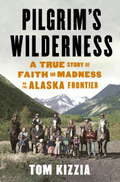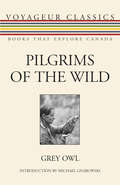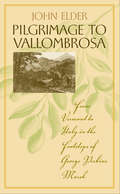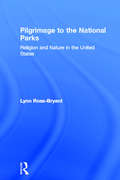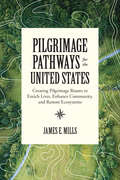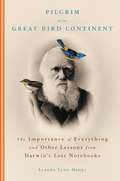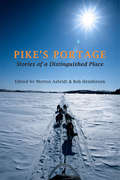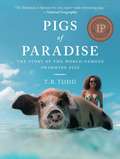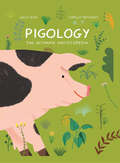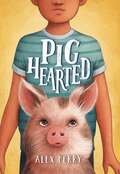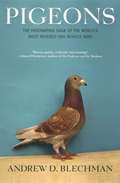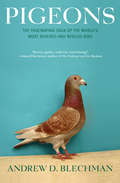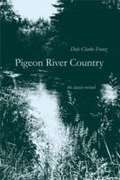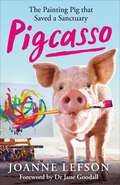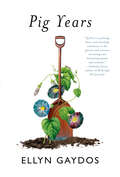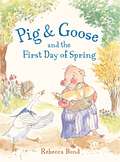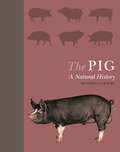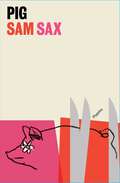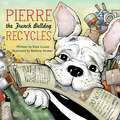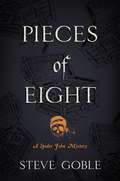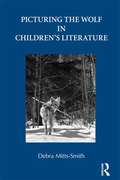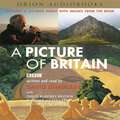- Table View
- List View
Pilgrim's Wilderness: A True Story of Faith and Madness on the Alaska Frontier
by Tom KizziaInto the Wild meets Helter Skelter in this riveting true story of a modern-day homesteading family in the deepest reaches of the Alaskan wilderness--and of the chilling secrets of its maniacal, spellbinding patriarch. When Papa Pilgrim, his wife, and their fifteen children appeared in the Alaska frontier outpost of McCarthy, their new neighbors saw them as a shining example of the homespun Christian ideal. But behind the family's proud piety and beautiful old-timey music lay Pilgrim's dark past: his strange connection to the Kennedy assassination and a trail of chaos and anguish that followed him from Dallas and New Mexico. Pilgrim soon sparked a tense confrontation with the National Park Service fiercely dividing the community over where a citizen's rights end and the government's power begins. As the battle grew more intense, the turmoil in his brood made it increasingly difficult to tell whether his children were messianic followers or hostages in desperate need of rescue. In this powerful piece of Americana, written with uncommon grace and high drama, veteran Alaska journalist, Tom Kizzia uses his unparalleled access to capture an era-defining clash between environmentalists and pioneers ignited by a mesmerizing sociopath who held a town and a family captive.
Pilgrims of the Wild
by Grey Owl Michael Gnarowski Hugh EayrsFirst published in 1935, Pilgrims of the Wild is Grey Owl’s autobiographical account of his transition from successful trapper to preservationist. With his Iroquois wife, Anahereo, Grey Owl set out to protect the environment and the endangered beaver. Powerful in its simplicity, Pilgrims of the Wild tells the story of Grey Owl’s life of happy cohabitation with the wild creatures of nature and the healing powers of what he referred to as "the great Northland" of "Over the Hills and Far Away." A bestseller at the time, Pilgrims of the Wild helped establish Grey Owl’s international reputation as a conservationist. His legacy of warnings against the degradations of nature and the dangers of industry live on, despite the posthumous revelation that he wasn’t, in fact, the First Nations man he claimed to be.
Pilgrims of the Vertical: Yosemite Rock Climbers and Nature at Risk
by Joseph E. Taylor Joseph E TaylorFew things suggest rugged individualism as powerfully as the solitary mountaineer testing his or her mettle in the rough country. Yet the long history of wilderness sport complicates this image. In this surprising story of the premier rock-climbing venue in the United States, Pilgrims of the Vertical offers insight into the nature of wilderness adventure. From the founding era of mountain climbing in Victorian Europe to present-day climbing gyms, Pilgrims of the Vertical shows how ever-changing alignments of nature, technology, gender, sport, and consumer culture have shaped climbers’ relations to nature and to each other. Even in Yosemite Valley, a premier site for sporting and environmental culture since the 1800s, elite athletes cannot be entirely disentangled from the many men and women seeking recreation and camaraderie. Following these climbers through time, Joseph Taylor uncovers lessons about the relationship of individuals to groups, sport to society, and nature to culture. He also shows how social and historical contexts influenced adventurers’ choices and experiences, and why some became leading environmental activists—including John Muir, David Brower, and Yvon Chouinard. In a world in which wild nature is increasingly associated with play, and virtuous play with environmental values, Pilgrims of the Vertical explains when and how these ideas developed, and why they became intimately linked to consumerism.
Pilgrimage to Vallombrosa: From Vermont to Italy in the Footsteps of George Perkins Marsh (Under the Sign of Nature: Explorations in Ecocriticism)
by John Elder"Set aside your Bella Tuscanys and Year in Provences for a different kind of travel book. Pilgrimage to Vallombrosa puts a walking stick in your hand and Marsh's Man and Nature in your knapsack, exploring how Italians have managed their natural and cultural heritage in ways that sustain both. John Elder's poetic meditations on land and life demonstrate that only by searching beyond our familiar boundaries can we discover better ways of living back at home."--Marcus Hall, author of Earth Repair: A Transatlantic History of Environmental Restoration "This collaboration--between George Perkins Marsh and John Elder, between Vermont and Italy, between maple and olive--is one of the smartest, soundest, deepest books about the relationship between people and nature that I've ever read. It will be a classic."--Bill McKibben, author of The End of Nature "Elder's impassioned pilgrimage shows us how to delight in messy wilderness, to secure a curative habitation of the world, and, with Marsh, to lend ecological nous to our gravest task: knowing ourselves and respecting one another. Let the maple seeds and olive stones of Elder's visionary harvest restore to us a reflective and redemptory future."--from the foreword by David LowenthalThe pivotal figure in Pilgrimage to Vallombrosa is the nineteenth-century diplomat and writer George Perkins Marsh, generally regarded as America's first environmentalist. Like Elder, Marsh was a Vermonter, and his diplomatic career took him for some years to Italy, where, witnessing the ecological devastation wrought upon the landscape by runaway deforestation and the plundering of other natural resources, he was moved to produce his famous manifesto, Man and Nature. Marsh drew parallels between the despoiled Italian environment and his home landscape of Vermont, warning that the latter was vulnerable to ecological woes of a similar magnitude if not carefully maintained and protected. In short, his was a prescient voice for stewardship. Elder follows in Marsh's footsteps along a trajectory running from Vermont to Italy, and at length fetches up at the managed forest of Vallombrosa. Punctuated throughout with learned and genial considerations of the poetry of Wordsworth, Basho, Dante, and Frost, Elder's narrative takes up issues of sustainability as practiced locally, reports on family doings, and returns finally--as did Marsh's--to Vermont, where he measures traditional stewardship values against more aggressive conservation-oriented measures such as the expansion of wilderness areas. John Elder, Professor of English and Environmental Studies at Middlebury College, is the author of Reading the Mountains of Home and The Frog Run. Under the Sign of Nature: Explorations in Ecocriticism
Pilgrimage to the National Parks: Religion and Nature in the United States (Routledge Studies in Pilgrimage, Religious Travel and Tourism)
by Lynn Ross-BryantNational Parks – ‘America’s Best Idea’ – were from the first seen as sacred sites embodying the God-given specialness of American people and American land, and from the first they were also marked as tourist attractions. The inherent tensions between these two realities ensured the parks would be stages where the country’s conflicting values would be performed and contested. As pilgrimage sites embody the values and beliefs of those who are drawn to them, so Americans could travel to these sacred places to honor, experience, and be restored by the powers that had created the American land and the American enterprise. This book explores the importance of the discourse of nature in American culture, arguing that the attributes and symbolic power that had first been associated with the ‘new world’ and then the ‘frontier’ were embodied in the National Parks. Author Ross-Bryant focuses on National Parks as pilgrimage sites around which a discourse of nature developed and argues the centrality of religion in understanding the dynamics of both the language and the ritual manifestations related to National Parks. Beyond the specific contribution to a richer analysis of the National Parks and their role in understanding nature and religion in the U.S., this volume contributes to the emerging field of ‘religion and the environment,’ larger issues in the study of religion (e.g. cultural events and the spatial element in meaning-making), and the study of non-institutional religion.
Pilgrimage Pathways for the United States: Creating Pilgrimage Routes to Enrich Lives, Enhance Community, and Restore Ecosystems
by James E. MillsAn inspirational argument for the creation of a new pilgrimage tradition in the United States.Pilgrimage is a sacred tradition that has existed around the world for centuries. Every year, more than one hundred million devotees from different cultures and faiths embark on journeys to such holy sites as Santiago de Compostela, Mecca, and Banaras. For some, making a pilgrimage is a spiritual act, while for others it is a secular experience of personal restoration. And yet there has never existed a tradition of pilgrimage within the United States.Cultural geographer James E. Mills makes a compelling case for the creation of a network of American pilgrimage routes to heal societal divisions and foster a new ethos of humanitarianism and environmentalism. He also addresses practical considerations for the development, ownership, and administration of future routes. Pilgrimage Pathways for the United States is for anyone considering a pilgrimage and for those of us who are interested in connecting and protecting our natural world, including environmentalists, interfaith clergy, political leaders, community developers, and activists.
Pilgrim on the Great Bird Continent: The Importance of Everything and Other Lessons from Darwin's Lost Notebooks
by Lyanda Lynn HauptSeattle-based environmental writer and ethicist Haupt considers Charles Darwin not just as a bearer of natural selection theory, but as a human who both understand and related to the natural world in such a way that this theory became possible. She draws from his little known Ornithological Notes, published only in 1963, to show how he attained his intellectual and moral maturity through studying the birds of South America. She has not indexed her work. Annotation ©2006 Book News, Inc., Portland, OR (booknews.com)
Pike's Portage: Stories of a Distinguished Place
by Morten Asfeldt Bob Henderson"Pike’s Portage plays a very special role in the landscape of Canada’s Far North and its human history. It is both an ancient gateway and the funnel for early travel from the boreal forest of the Mackenzie River watershed to the vast open spaces of the subarctic taiga, better known as the "Barren Lands" of Canada. "This book is a rich and wonderful comopendium of stories about this area and the early white explorers, the Dene guides, the adventurers, the trappers, the misguided wanderers (like John Hornby) as well as the modern-day canoeists who passed this way. For the reader, it provides an absorbing escape into the past and the endless solitude of the northern wilderness." – George Luste, wilderness canoeist, physics professor (University of Toronto), and founder-organizer of the annual Wilderness Canoeing Symposium. "So why do people come to this place, this Pike’s Portage in particular? The call of landscape is potent and these word portraits collected here offer up some of those who have answered. Both subject and writer reveal the complexities of human perception. Some are called by the profound power of inherited cultural meaning, while a huge dose of imagination draws others from far away. These worlds seldom truly meet, even in a place as busy as this, but whether it is homeland or wilderness, human histories are recorded in footprints, place names, and memory, and here we stand with a magnificent view, marvelling at it all." – Susan Irving, Curatorial Assistant, Prince of Wales Northern Heritage Centre, Yellowknife, NWT
Pigs of Paradise: The Story of the World-Famous Swimming Pigs
by T. R. Todd“The Bahamas are famous for sun, sand—and swimming pigs.” —National GeographicIn the middle of paradise, with billionaires and celebrities for neighbors, is an island populated only by swimming pigs. For decades, this archipelago of 365 islands would remain largely unknown to the world. It would not be a ruthless pirate, pioneering loyalists, a notorious drug kingpin, or the infamous Fyre Festival that would unveil Exuma to the world, but rather the most unlikely of creatures. Appearing in magazines, videos, newspapers, commercials, TV shows, and countless selfies, the Swimming Pigs of Exuma, in the Bahamas, have become a bucket-list sensation and have been named one of the marvels of the universe. But how did they reach this celebrity status? What made them so famous? And why, in February 2017, did so many of them die? Pigs of Paradise is an unlikely story of humble beginnings and a swift rise to stardom. With interviews from historians, world-renowned ecologists, famous pig owners, and boat captains, it thoughtfully considers what this phenomenon says about not only these animals but also about us.
Pigology: The Ultimate Encyclopedia
by Daisy Bird Camilla PintonatoWelcome to the wonderful world of pigs! Pigology is filled with incredible pig facts told in a playful tone by Daisy Bird with irresistibly charming illustrations by rising star Camilla Pintonato.Pigs are full of unexpected surprises. Did you know that when a pig is happy, it will uncoil its curly tail and wag it just like a dog? Or that feral hogs can detect odors from seven miles away? Pigology delves into the history of pigs, pig breeds around the world, famous pigs, pigs in culture, and so much more, with engaging scenes from illustrator Camilla Pintonato. This lively, visual encyclopedia, a follow-up to Chickenology, has something to discover for everyone young and old: nature and animal loving young readers, pig enthusiasts, pig farmers, and pet pig owners alike!
Pighearted
by Alex PerryCharlotte's Web meets My Sister's Keeper in this charming story told from the alternating perspectives of a boy with a fatal heart condition and the pig with the heart that could save his life.Jeremiah&’s heart skips a beat before his first soccer game, but it&’s not nerves. It&’s the first sign of a heart attack. He knows he needs to go to the hospital, but he&’s determined to score a goal. Charging after the ball, he refuses to stop…even if his heart does.J6 is a pig and the only one of his five brothers who survived the research lab. Though he's never left his cell, he thinks of himself as a therapy pig, a scholar, and a bodyguard. But when the lab sends him to live with Jeremiah's family, there&’s one new title he&’s desperate to have: brother.At first, Jeremiah thinks his parents took in J6 to cheer him up. But before long, he begins to suspect there's more to his new curly-tailed companion than meets the eye. When the truth is revealed, Jeremiah and J6 must protect each other at all costs—even if their lives depend on it.
Pigeons: The Fascinating Saga of the World's Most Revered and Reviled Bird
by Andrew D. BlechmanFrom the Book Jacket: They have been worshiped as fertility goddesses and revered as symbols of peace. Domesticated since the dawn of man, they have been crucial to wartime communications for every major historical superpower from ancient Egypt to the United States and are credited with saving thousands of lives. One delivered the results of the first Olympics in 119 B.C. and another brought the news of Napoleon's defeat at Waterloo more than 2,500 years later. Charles Darwin relied heavily upon them to help formulate and support his theory of evolution. Yet the pigeon is reviled today as a rat with wings. How did we come to misunderstand one of mankind's most steadfast companions? In Pigeons, Andrew D. Blechman travels across the United States and Europe in a quest to chronicle the bird's transformation from beloved friend to feathered outlaw. From Brooklyn's Main Event, the pigeon world's equivalent of the Kentucky Derby, to the eighty-third Grand National, with its thousands of bizarre and beautiful show pigeons, and from a pigeon shoot where people pay to gun down live birds, to the nation's oldest and biggest squab farm, Blechman takes the reader deep into the weird and wonderful world of pigeon fanaticism. He meets with pigeon fanciers and pigeon haters alike, includingthe Queen of England's Royal Loft Manager and members of the radical "pro-pigeon underground"; chases Mike Tyson, America's most famous pigeon lover; and for the first time tells the remarkable story behind this seemingly unremarkable bird. You'll never look at a pigeon the same way again. ! ANDREW D. BLECHMAN is an award- winning journalist who has worked for the Los Angeles Times and the Des Moines Register. His writing has appeared in numerous publications, including Smithsonian magazine and The New York Times. He currently divides his time between Berkshire County, Massachusetts, and Germany.
Pigeons: The Fascinating Saga of the World's Most Revered and Reviled Bird
by Andrew D. BlechmanPigeons have been worshipped as fertility goddesses and revered as symbols of peace. Domesticated since the dawn of man, they’ve been used as crucial communicators in war by every major historical superpower from ancient Egypt to the United States and are credited with saving thousands of lives. Charles Darwin relied heavily on pigeons to help formulate and support his theory of evolution. Yet today they are reviled as "rats with wings.” Author Andrew D. Blechman traveled across the United States and Europe to meet with pigeon fanciers and pigeon haters in a quest to find out how we came to misunderstand one of mankind’s most helpful and steadfast companions. Pigeons captures a Brooklyn man’s quest to win the Main Event (the pigeon world’s equivalent of the Kentucky Derby), as well as a convention dedicated to breeding the perfect bird. Blechman participates in a live pigeon shoot where entrants pay $150; he tracks down Mike Tyson, the nation’s most famous pigeon lover; he spends time with Queen Elizabeth’s Royal Pigeon Handler; and he sheds light on a radical "pro-pigeon underground’ in New York City. In Pigeons, Blechman tells for the first time the remarkable story behind this seemingly unremarkable bird.
Pigeon River Country: A Michigan Forest
by Franz Dale ClarkeThe long awaited new edition of a classic offers memories, myths, and meanings of the largest contiguous piece of wild land in Michigan's Lower Peninsula. This updated edition explores more deeply why and how the outdoors moves and compels us. It’s a book about mice who sing, elk who wear collars, deer who kiss, and birds who could dictate their compositions to Mozart. It's about the human species interacting in generous and sometimes misguided ways with the rest of life. It's about men trying to ripen pinecones into pineapples and women taking better aim with a revolver than expected. It's about poetry—from Mary Oliver, Lao Tzu, and Theodore Roethke—and seeing hawks dive in a night sky or feeling oil geologists shake the earth below. It's about finding fish dead in the river by the thousands and crouching behind a stump to watch beaver build a dwelling. While this book considers life beyond the boundaries of Pigeon River Country, it is steeped in the specifics of a place that lives mostly on its own, instead of human, terms. The Pigeon River Country is a remote northern forest, ecologically distinct from most of the United States. Laced with waterways, it has a storied past. Dale Clarke Franz has collected personal accounts from various people intrigued with the Pigeon River Country—including loggers, conservationists, mill workers, campers, even the young Ernest Hemingway, who said he loved the forest "better than anything in the world. " There are comprehensive discussions of the area's flora and fauna, guides to trails and camping sites, and photos showcasing the changing face of this hidden national treasure.
Pigcasso: The painting pig that saved a sanctuary
by Joanne LefsonWhen Joanne Lefson took on a piglet at her animal shelter, the young sow proceeded to eat everything in her stable but a paint brush. In a flash of inspiration, Joanne attempted to introduce the pig to the art of painting - and thus Pigcasso was born. Starting out with a humble canvas on the sanctuary wall, Pigcasso's paintings are now owned by the likes of George Clooney, she has a Swatch watch design partnership, a wine label, and has eclipsed the previous world record holder for animal art. She's been commissioned by Nissan and has had exhibitions in Cape Town, Munich and Amsterdam. More than that, Pigcasso's art funds the food and veterinary services for all the animals at the sanctuary.Pigcasso is the story of this unique pig and of the circumstances that brought her and Joanne together to take the art world by storm and form a unique and unbreakable bond.
Pig Years
by Ellyn GaydosThis captivating memoir is a &“startling testimony to the glories and sorrows of raising and harvesting plants and animals&” (Anthony Doerr, best-selling author of All the Light We Cannot See), as an itinerant farmhand chronicles the wonders hidden within the ever-blooming seasons of life, death, and rebirth.Pig Years catapults American nature writing into the 21st century, and has been hailed by Lydia Davis and Aimee Nezhukumatathil as &“engrossing&” and &“a marvel.&” As a farmer in Upstate New York and Vermont, Ellyn Gaydos lives on the knife edge between loss and gain. Her debut memoir draws us into this precarious world, conjuring with stark simplicity the lifeblood of the farm: its livestock and stark full moons, the sharp cold days lives near to the land. Joy and tragedy are frequent bedfellows. Fields go barren and animals meet their end too soon, but then their bodies become food in a time-old human ritual. Seasonal hands are ground down by the hard work, but new relationships are formed, love blossoms and Gaydos yearns to become a mother. As winter&’s dark descends, Pig Ears draws us into a violent and gorgeous world where pigs are star-bright symbols of hope and beauty surfaces in the furrows, the sow, even in the slaughter. In hardy, lyrical prose that recalls the agrarian writing of Annie Dillard and Wendell Berry, Gaydos asks us to bear witness to the work that sustains us all and to reconsider what we know of survival and what saves us. Pig Years is a rapturous reckoning of love, labor, and loss within a landscape given to flux.
Pig & Goose and the First Day of Spring
by Rebecca BondFind Pig and Goose a place on the friendship shelf with the likes of Frog and Toad, Elephant and Piggie, and Houndsley and Catina. —Kirkus ReviewsAn unlikely friendship springs to life with good humor, kindness, and compassion. In this early reader with five short chapters, emerging readers meet Pig and Goose. Pig is happy. She loves to dance. She loves to eat. But she cannot fly. And she cannot swim. Goose can fly like a bird. Goose can glide across the water beautifully. But he cannot tell stories or host a party like Pig can. Pig and Goose are very different. But what they do have in common is that they like each other. And they love springtime.Simple text and charming illustrations guide beginning readers throughout the story and encourage independent reading.
The Pig: A Natural History
by Richard LutwycheA comprehensive, richly illustrated introduction to the fascinating natural history of the pig, from prehistory to the present At any given time, there are around one billion pigs in the world; that's one for every seven of us. And where would we be without them? Prolific, ubiquitous, smart, adaptable, and providers of high-quality protein, pigs have been our companions since neolithic times, when they obligingly domesticated themselves, coming in from the wild to root around our waste pits. But it's not all about the bacon; today, bred in micro sizes, the resourceful pig has developed a whole new career as a popular pet. And thanks to genome mapping, we now know that the pig shares many common physiological features with humans, spurring the use of pig tissue and organs in medical research and surgery. Beautifully designed and illustrated, The Pig provides a snout-to-tail natural history of this important species, from the prehistoric "hell pig" to today's placid porker, covering the pig's evolution and domestication, anatomy and biology, behavior, role in human life and culture, and breeds. The book also features an engrossing and visually stunning photographic gallery of some thirty popular breeds from around the world, with essential information about each. Filled with surprising facts and insights, The Pig will delight anyone who loves these animals and wants to understand them better. Provides a comprehensive, richly illustrated introduction to the pig's evolution and domestication, anatomy and biology, behavior, role in human life and culture, and breeds. Features infographics, diagrams, and 250 stunning color photographs. Includes a beautiful photographic directory to some 30 popular breeds from around the world, with essential information about each
Pig: Poems
by Sam SaxFrom the brilliantly talented National Poetry Series and James Laughlin Award winner comes a third collection of poems that uses the humble pig as a lens to explore the body, faith, desire, and power.This imaginative and singular poetry collection interrogates the broadest ideas surrounding the humble pig—farm animal, men/masculinity, police and state violence, desire, queerness, global food systems, religion/Judaism and law—to reimagine various chaotic histories of the body, faith, ecology, desire, hygiene, and power. Sam Sax draws on autobiography and history to create poems that explore topics ranging from drag queens and Miss Piggy to pig farming and hog lagoons. Collectively, these poems, borne of Sax&’s obsession, offer a varied picture of what it means to be a human being. Delivered in a variety of forms, infused with humor, grace, sadness, and anger, Pig is a wholly unique collection from a virtuosic and original poet.
Pierre the French Bulldog Recycles
by Bethany Straker Kate LouiseLike most dogs, Pierre, a French bulldog, loves the excitement of digging things up. He hoards his treasures in a hole in the backyard and then makes space for more. One day Pierre tosses some old stuff into the trash can, but he forgets to recycle. Now, instead of being transformed into new things, that plastic bottle and newspaper will sit in a landfill forever! Well, not if Pierre has anything to do with it. He chases the garbage truck through town, but will he catch it in time, or will those treasures be trash forever? From author Kate Louise comes Pierre the French Bulldog Recycles--a quirky and fun lesson about the importance of recycling. Bethany Straker’s expressive illustrations make this adorable pup come to life on every page and are sure to get kids thinking about the importance of saving the environment one small piece of trash at a time.
Piecing Makeover: Simple Tricks to Fine-Tune Your Patchwork
by Patty MurphyDo your quilt blocks tend to misbehave? Perfect your patchwork with a visual, step-by-step guide to 21 popular quilt blocks. Piecing expert Patty Murphy shows you how with fail-proof techniques that can be used in all types of quilt designs, from traditional to modern. Say goodbye to patchwork problems like mismatched seams, blunt points, and too-small blocks, and learn to avoid common mistakes in sashings, borders, and bindings. Though mistakes happen to all of us, these easy techniques will help beginning and intermediate quilters achieve quiltmaking success every time. • Learn to flawlessly construct 21 popular blocks in both traditional and modern designs • Step-by-step photos guide new and intermediate quilters • Avoid common patchwork problems like mismatched seams with expert tips from a lifelong quilter
Pieces of Eight (A Spider John Mystery #4)
by Steve Goble1723—Spider John is almost home, free of the horrors of the pirate life, free of the violence, free of the death. The wife and baby he left behind almost a decade ago are almost within reach. But then a murder aboard Minuet uncovers a deeper conspiracy, and soon Spider and his friends—curmudgeonly Odin, swashbuckling young Hob and alluring Ruth Copper— find themselves in the midst of flintlock smoke and bloodshed. The violence follows Spider ashore to Nantucket, where the loving reception he&’d dreamed of turns out to be something utterly unexpected. Soon, Spider is running for his life and confronting cutthroats and thieves — while hiding from islanders who think he left a man dead on a widow&’s front step. The solution? Find the killer. The consequences? Those could change Spider John&’s life forever.
Picturing the Wolf in Children's Literature (Children's Literature and Culture #69)
by Debra Mitts-SmithFrom the villainous beast of “Little Red Riding Hood” and “The Three Little Pigs,” to the nurturing wolves of Romulus and Remus and Rudyard Kipling’s The Jungle Book, the wolf has long been a part of the landscape of children’s literature. Meanwhile, since the 1960s and the popularization of scientific research on these animals, children’s books have begun to feature more nuanced views. In Picturing the Wolf in Children’s Literature, Mitts-Smith analyzes visual images of the wolf in children’s books published in Western Europe and North America from 1500 to the present. In particular, she considers how wolves are depicted in and across particular works, the values and attitudes that inform these depictions, and how the concept of the wolf has changed over time. What she discovers is that illustrations and photos in works for children impart social, cultural, and scientific information not only about wolves, but also about humans and human behavior. First encountered in childhood, picture books act as a training ground where the young learn both how to decode the “symbolic” wolf across various contexts and how to make sense of “real” wolves. Mitts-Smith studies sources including myths, legends, fables, folk and fairy tales, fractured tales, fictional stories, and nonfiction, highlighting those instances in which images play a major role, including illustrated anthologies, chapbooks, picture books, and informational books. This book will be of interest to children’s literature scholars, as well as those interested in the figure of the wolf and how it has been informed over time.
A Picture Of Britain: n/a
by David DimblebyAccompanying a major BBC1 series presented by David Dimbleby, and an exhibition at Tate Britain, A Picture of Britain is a celebration of the British landscape and the art that it has inspired, from Constable to Lowry, from Turner to Nash. From the slopes of Snowdonia to the industrial Black Country, from the grandeur of the Scottish Highlands to the meadows of Suffolk, the British landscape has inspired artists and writers for generations. This remarkable book, read by all four contributors, captures our rich cultural heritage, creating for the listener A Picture of Britain.(p) 2006 Orion Publishing Group
A Picture Book of Flowers
by Theresa GraceLovely paintings of flowers and an accurate narrative. This small book could motivate children to become interested in the science of plants and the aesthetic value that plants provide.
